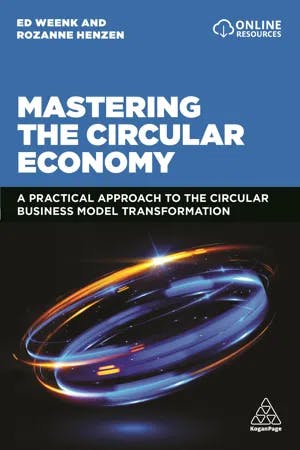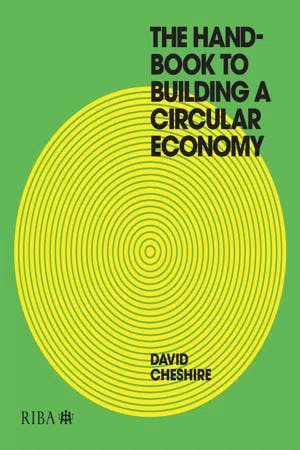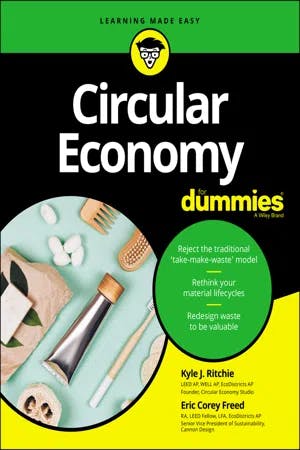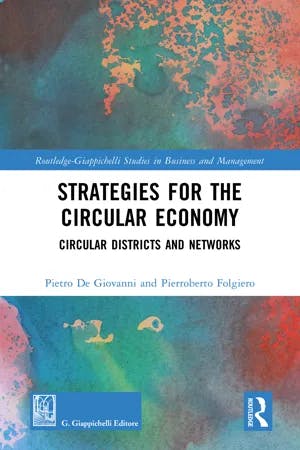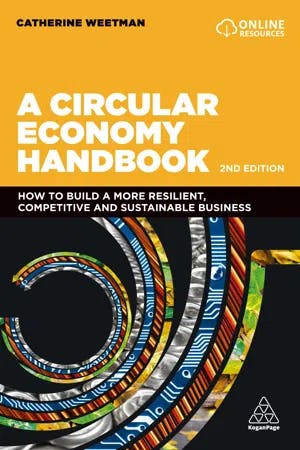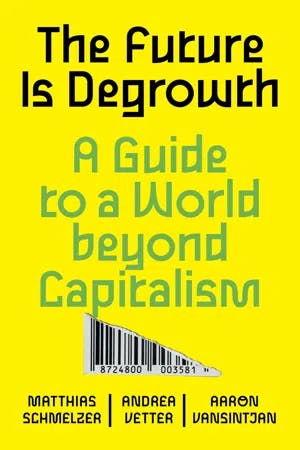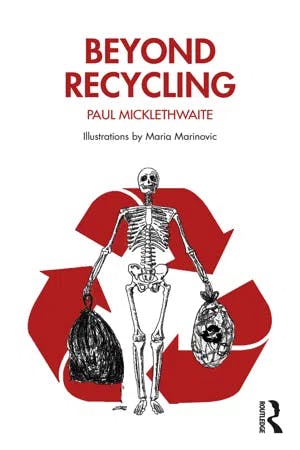What is The Circular Economy?
MA, Sociology (Freie Universität Berlin)
Date Published: 04.10.2023,
Last Updated: 11.01.2024
Share this article
Defining the circular economy
To explain what a circular economy is, it’s useful to begin by defining its opposite: the linear economy. A linear economy follows the take-make-dispose model, and is one way of describing how we currently produce and consume goods. Raw materials are extracted, used to manufacture products, and then disposed of in oceans, landfills, and so on. In a circular economy, on the other hand,
… closed loops and cycles are introduced into the value chain to organize the return flows of products and materials, for the purpose of recycling, remanufacturing, reuse or other value retention strategies… (2021)
Ed Weenk & Rozanne Henzen
… closed loops and cycles are introduced into the value chain to organize the return flows of products and materials, for the purpose of recycling, remanufacturing, reuse or other value retention strategies… (2021)
These strategies are intended to drastically mitigate waste and, ultimately, restore the natural environment. Proponents of circular economic models view it as instrumental in the fight against climate change in this Anthropocene era, a key aspect of building a more sustainable future that decouples production from the extraction of earth’s natural resources.
Circular economy practices and principles include but are not limited to the cradle-to-cradle philosophy, eco-design, product leasing, biomimicry, and the use of digital technology for more efficient natural resource management. In this study guide we will explore each of these, and then look at some tangible examples and initiatives where these approaches are currently being implemented. Finally, we will conclude with an overview of critiques of the circular economic model and some reflections on the future outlook and potential of the circular economy.
Key principles of a circular economy
Biomimicry
Circular economies take much of their inspiration from nature, as natural ecologies are composed of plants, animals, and other organisms whose life cycles are deeply intertwined with one another. In fact, this emphasis on ecological systems is perhaps the core underlying approach that subtends all other practices and principles associated with the circular economy.
Moreover, in terms of sustainability thinking, David Cheshire points out that nature makes a remarkable array of biodiversity possible while predominantly using a relatively limited set of the periodic table of elements,
Nature uses structure and form to create stiffness, flexibility and even colour from its limited palette of materials. Structural elements such as bones and tree trunks use complex forms to create light, efficient structures from microstructures that start at the molecular level. A butterfly’s wing is coloured not by pigmentation but by a microstructure that refracts light. (2021)
David Cheshire
Nature uses structure and form to create stiffness, flexibility and even colour from its limited palette of materials. Structural elements such as bones and tree trunks use complex forms to create light, efficient structures from microstructures that start at the molecular level. A butterfly’s wing is coloured not by pigmentation but by a microstructure that refracts light. (2021)
In turn, through the use of resourcefulness and technological ingenuity, proponents of circular economic models argue that we can also learn to be more creative and efficient with how we utilize resources and redirect the byproducts produced from industrial processes.
Cradle to cradle
Relatedly, another one of the central philosophies of the circular economy is thinking in terms of “cradle to cradle.” This comes as an alternative to “cradle-to-grave” thinking, as one might in the linear economy where we buy something new and then throw it away once we’re finished using it. Rather, a circular economic model is largely defined by rejecting the concept of waste, and instead viewing all byproducts as inputs for other production processes. As Eric Corey Freed puts it,
Waste doesn’t exist within the natural world; there, every output of a system acts as an input for another. Leaf litter isn’t litter at all, but a source of food for insects and eventually a food source for the tree to grow leaves again next year. The carbon dioxide emitted through animal respiration is harvested by vegetation and replaced with the oxygen required to future support animal respiration. Material lifecycles within nature are circular, not linear. Every output of one systems serves as an input for another. (2021)
Eric Corey Freed
Waste doesn’t exist within the natural world; there, every output of a system acts as an input for another. Leaf litter isn’t litter at all, but a source of food for insects and eventually a food source for the tree to grow leaves again next year. The carbon dioxide emitted through animal respiration is harvested by vegetation and replaced with the oxygen required to future support animal respiration. Material lifecycles within nature are circular, not linear. Every output of one systems serves as an input for another. (2021)
In other words, every byproduct serves as healthy food for something else. On a household level, cradle-to-cradle thinking could look like saving food scraps for composting to fertilize fruit and vegetable plants in a garden. At the business level, it might look like using packaging that has been made out of 100% recycled materials.
Eco-design
At its simplest, eco-design in a circular economy refers to designing production processes to minimize environmental impact to the utmost degree. A circular economy is very much predicated on intentionally structuring the entire value chain to achieve maximum environmental efficiency, as a key way of putting the aforementioned philosophies into practice. As Pietro De Giovanni and Pierroberto Folgiero explain,
The main strategies for eco-design are as follows: Using materials with low environmental impact, choosing clean production processes, avoiding hazardous and toxic materials, maximizing the efficiency of the energy used for production and for the product in use, and designing for waste management and recycling. (2023)
Pietro De Giovanni & Pierroberto Folgiero
The main strategies for eco-design are as follows: Using materials with low environmental impact, choosing clean production processes, avoiding hazardous and toxic materials, maximizing the efficiency of the energy used for production and for the product in use, and designing for waste management and recycling. (2023)
The point of eco-design, therefore, is not only to take into account how waste products can be used in other ways, but to generate less waste in the first place. From the supply side, rather than planned obsolescence that has become common in many electronics, manufacturers could design their products to be repaired and refurbished. And while eco-design often focuses on the large-scale systems of actors and firms involved in the commodity production process, its principles can also be applied to individual consumer products themselves. For instance, investing in reusable to-go containers rather than using disposable coffee cups would be a way that consumers can support eco-design.
Product leasing
Another innovative practice associated with circular economies involves shifting how we think about purchasing, consuming, and owning products. Rather than taking a more linear approach of buying something new, using it, and disposing of it when we are finished, many proponents advocate for product leasing. Continuing with De Giovanni and Folgiero’s explanation of circular economic principles,
Product leasing is a service model in which a user pays for the access and the usage of a product during a certain period. Manufacturers typically maintain ownership of the product and are responsible for delivery, maintenance, and all take-back activities. Leasing allows the circular economy system to mitigate uncertainty on quantity, quality, and timing of returns. (Strategies for the Circular Economy, 2023)
In this sense, a person might buy an appliance such as a refrigerator and use it for a set amount of time and then return it to the supplier who can then refurbish it to sell to someone else, or disassemble and reuse the materials. Similarly, product leasing might take the form of tool libraries where people can rent things like power drills and then return them when they’re done. Thus, rather than viewing companies as producers of commodities, in a circular economy, they’d be more like service providers.
The internet of things (IoT)
Finally, a circular economy utilizes the internet of things (IoT) to increase the overall efficiency of production processes and to reduce environmental impacts. As Catherine Weetman asserts,
The Internet of Things (IoT) or ‘intelligent assets’ have scope to extend the lifetimes of asset and product, reduce their in-use consumption, and help with their effective recovery at end-of-use. This connectivity between devices and physical infrastructure is referred to as the Internet of Things or the ‘industrial internet’ ... IoT has great potential to reduce energy use and improve time- and resource-efficiency across many sectors. (2020)
Catherine Weetman
The Internet of Things (IoT) or ‘intelligent assets’ have scope to extend the lifetimes of asset and product, reduce their in-use consumption, and help with their effective recovery at end-of-use. This connectivity between devices and physical infrastructure is referred to as the Internet of Things or the ‘industrial internet’ ... IoT has great potential to reduce energy use and improve time- and resource-efficiency across many sectors. (2020)
Even within an individual home, smart devices can significantly reduce energy consumption by monitoring heating and air-conditioning systems and automatically shutting off once a certain temperature is reached. Yet, the utility of the IoT is manifold on an industrial level in building and facilities management, in agriculture, and even in monitoring liquid cooling systems which are essential to maintaining large internet servers. Thus, the IoT can be an essential part of monitoring and mitigating excess energy expenditures that improve overall resource management and energy efficiency.
Main drivers of the circular economy
Businesses and the private sector
Perhaps not surprisingly, in much of the literature on the circular economy the private sector is regarded as the main arena where these transitions ought to take place.Circular economy proponents emphasize that designing the entire supply chain to drastically reduce or even eliminate waste products by redirecting them to other industries will make the largest environmental impact. In fact, according to a report by European Investment Bank cited in The Circular Economy,
One of the key findings in the related trailblazing report entitled “Re-configure: The Circular Economy – a Powerful Force for Climate Mitigation” [85], is that more CE initiatives in key economic sectors could cut EU industrial emissions by more than half by 2050. … Globally, the reductions could be 3.6 billion tons per year in the same period. Industry accounts for 24% of global CO2 emissions, which stood at 37 billion tons in 2017. (2019)
Mika Sillanpaa & Chaker Ncibi
One of the key findings in the related trailblazing report entitled “Re-configure: The Circular Economy – a Powerful Force for Climate Mitigation” [85], is that more CE initiatives in key economic sectors could cut EU industrial emissions by more than half by 2050. … Globally, the reductions could be 3.6 billion tons per year in the same period. Industry accounts for 24% of global CO2 emissions, which stood at 37 billion tons in 2017. (2019)
Specifically, scholars and analysts point to industries dealing with manufacturing materials like metals, plastics, and cement, as well as to sectors such as agriculture, energy, and textiles as key areas where the circular economy could usher in more environmental sustainability. For example, the popular clothing chain, H&M, has already adopted circular economy principles such as building circular systems in their supply chains that aid in the reuse, repair, and recycling of textiles rather than throwing them away.
Beyond the positive environmental impact, circular economy proponents have also made a business case for its adoption. They argue that new jobs can be created from the process of turning byproducts into valuable inputs for other sectors and industries. Take, for example, another report cited in A Circular Economy Handbook,
The World Economic Forum believes a ‘shift to circular economic activity could help address the global job gap of 600 million’, along with many other benefits across a range of market sectors.4 Accenture estimates that ‘shifting to the circular economy could release US$4.5 trillion in new economic potential by 2030’ (Catherine Weetman, 2020)
Others claim that applying a cradle-to-cradle philosophy by finding ways to utilize “waste” products can save businesses money in the long run, as it is expensive to extract natural resources such as metals like copper or lithium from the ground. Still, these reports remain speculative as it remains to be seen which costs and risks might be involved with adopting a circular economic approach in many sectors.
Public policy initiatives
The public sector is also a leading actor in driving the adoption of the circular economy, as they can help mitigate some of the business risks associated with transitioning to the circular economic model and incentivize corporations to do so. Government initiatives to support a circular economy can be found around the world, including in Africa, Latin America, and Asia. That said the European Union is currently where the most comprehensive efforts are being made to facilitate the transition towards a circular economy. For example, as Ed Weenk and Rozanne Henzen observe in Mastering the Circular Economy,
In 2020, the European Union presented their Green Deal and Circular Economy Action Plan: ‘Climate change and environmental degradation are an existential threat to Europe and the world. To overcome these challenges, Europe needs a new growth strategy that will transform the Union into a modern, resource-efficient and competitive economy, where:
1.) there are no net emissions of greenhouse gases by 2050;
2.) economic growth is decoupled from resource use;
3.) no person and no place is left behind.
The European Green Deal is our plan to make the EU’s economy sustainable. We can do this by turning climate and environmental challenges into opportunities, and making the transition just and inclusive for all’ (EU, 2019, 2020). Points 1 and 2 in particular have direct connections to circularity and are likely to be a driving force behind circular initiatives. (2021)
In line with these goals, the European Investment Bank has invested EUR 3.4 billion into 118 circular economy projects. One of the most well known is the WEE (Waste of Electrical Equipment) directive which facilitates collection schemes where consumers can return electronics to be recycled for free. Moreover, such efforts are also supported by other organizations such as Ellen MacArthur Foundation, United Nations Environment Programme, and The World Economic Forum, which set guidelines and seek to influence policies that align with the circular economic model.
Culture and society
Beyond the role of large corporations and political actors, the transition towards a circular economy has major social and cultural dimensions as well. For one, it necessitates a shift in attitudes and norms around consumption and waste. This dimension of the circular economy often gets less attention than the role of the private sector and governments do. Yet, researchers like Viktor Pál,
emphasise the role of actors that sit outside of the formal organisations of the market economy. [He] argue[s] that these play a crucial role in local food transformation (e.g., grassroots innovations) ... but are often absent in the mainstream CE policy frame (e.g., EU policies, major circular city strategies, corporate plans, etc.). (2022)
Viktor Pál
emphasise the role of actors that sit outside of the formal organisations of the market economy. [He] argue[s] that these play a crucial role in local food transformation (e.g., grassroots innovations) ... but are often absent in the mainstream CE policy frame (e.g., EU policies, major circular city strategies, corporate plans, etc.). (2022)
While the supply side of products and systems that enable better practices around these matters are fundamental, buying things to last or leasing them, repairing them when they are broken, and taking the time and effort to recycle and share goods are also instrumental to a healthy circular economy. Here it is also important to note that many traditional livelihoods and indigenous cultures, particularly in the global South, already practice circular economy principles and these could offer sources of guidance in the transition towards a more sustainable future.
Critiques of circular economy
Market critique
One of the main criticisms of the circular economy is that it places too much centrality on the market as a vector for driving environmentally sustainable change. These critics point to the fact that large corporations are themselves among the largest polluters worldwide because short term economic growth is essential to staying afloat within market economies. This potentially places businesses and corporations at odds with taking business risks to invest in circular economic principles and practices on a scale that could effectively mitigate climate change. Put simply, decision makers in some of the highest polluting industries, such as oil and gas, have too much invested in keeping things the way they are to be the pioneers of a more sustainable economic model.
As an alternative to centering the market as is the case in the circular economic model, proponents of degrowth problematize the structural and economic systems themselves as fundamentally at issue in assessing environmental degradation. As explained in The Future is Degrowth,
Degrowth starts from the fact – demonstrated by an increasing number of studies – that further economic growth in industrialized countries is unsustainable. Even if that growth is ‘green’ or ‘inclusive’, or even as part of a transformative progressive agenda that massively invests in renewable energies and the sustainability transition, industrialized countries cannot reduce their environmental impact (emissions, material throughput, etc.) fast and sufficiently enough while, at the same time, growing their economies. (2022)
Matthias Schmelzer, Andrea Vetter & Aaron Vansintjan
Degrowth starts from the fact – demonstrated by an increasing number of studies – that further economic growth in industrialized countries is unsustainable. Even if that growth is ‘green’ or ‘inclusive’, or even as part of a transformative progressive agenda that massively invests in renewable energies and the sustainability transition, industrialized countries cannot reduce their environmental impact (emissions, material throughput, etc.) fast and sufficiently enough while, at the same time, growing their economies. (2022)
Rather than simply attempting to reform the economy, proponents of degrowth advocate for broader structural change to curtail the worst of capitalism. These shifts might include the socialization of public goods like energy, natural resources, and housing in an effort to use resources not for the benefit of corporations, but for the good of the people and the planet.
Environmental critique
Other critics of the circular economic model argue that there are actually environmental concerns around what it means to harness and reuse industrial waste products. Many experts argue that doing so will never be 100% possible and what’s more, that recycling waste products in many cases is itself very resource intensive. As Paul Micklethwaite points out,
Shipping waste around the world in huge quantities makes little sense environmentally due to the transportation impacts. We are told to recycle for the sake of the environment. Globally distributed recycling diminishes the value of our recycling efforts. (2021)
Paul Micklethwaite
Shipping waste around the world in huge quantities makes little sense environmentally due to the transportation impacts. We are told to recycle for the sake of the environment. Globally distributed recycling diminishes the value of our recycling efforts. (2021)
Plus, not all byproducts are truly recyclable such as toxic and contaminated materials, chemical compounds that are not easily separated into their constituent parts for reuse, or items that are simply too expensive to recycle to be financially viable. Moreover, this often applies to the most environmentally harmful waste products. Thus, it is argued that some of the objectives of the circular economy are overly optimistic in terms of their actual impacts in mitigating environmental harm.
Social justice critique
Finally, some critics of the circular economy such as Micklethwaite argue that it lacks a clear analysis of power by taking a top down approach that leaves the experiences of regular people out of the conversation. While much of the literature on the circular economy is set on appealing to the interests of governments and private sector firms, there is little emphasis placed on what a just transition to this economic model would look like. Specifically, those who make a social justice critique of the circular economy point to things like working conditions in many of the industries that are likely to be involved in making such a transition a reality. Continuing with Micklethwaite,
Electrical and electronic waste streams are growing rapidly worldwide, meaning more people are forced to work in awful conditions on our behalf elsewhere in the world due to our consumption (World Economic Forum, 2019). If it is economically viable for waste materials to be recovered, they will be, somewhere in the world. As with the exploitative production of cheap clothing, human costs are acknowledged but generally overlooked in the global recycling industry. (2021)
Those who work in industries emphasized as being essential to bringing about a circular economic model such as textiles, mining, manufacturing, and agriculture are often among the world’s most marginalized — often feminized, poor, and outsourced to the global South. Therefore, social justice critics contend that facilitating a transition towards a circular economy ought to involve creating more just and equitable labor conditions rather than exacerbating them. For more information on this, Ecofeminism is a good starting point for understanding the push for social justice in climate policy.
Closing thoughts
The circular economic model presents an alternative paradigm for the production and consumption of goods that is geared towards a more environmentally sustainable future. Through adopting alternative principles and practices such as biomimicry, eco-design and product leasing, its proponents argue that market economies can be transformed from a force that harms the environment to one that promotes healthy ecologies at the global scale. Research suggests that the circular economic model has the potential to drastically reduce waste, offset natural resource extraction, and create new jobs.
Its critics, however, argue that this picture may be overly optimistic. They contend that looking to market actors and elites to drive these shifts is dubious because these are the same forces that have been the biggest drivers of pollution, and that the circular economic model ignores social justice issues such as labor conditions. Moreover, some environmental experts also point out that it is not possible to transform waste products into useful forms for other industrial processes, and when doing so is possible, is itself resource intensive.
While these critiques ought to be confronted and addressed, the circular economy and its constituent innovations still shed light on an alternative way forward toward a green transition. They offer a practical blueprint for staving off some of the worst impacts of climate change. Through the cooperation between the private sector, public policy initiatives, and the general public, the circular economy certainly provides one valuable piece of the puzzle in creating a more sustainable future.
Further reading on Perlego
Designing for the Circular Economy (2018) by Martin Charter
The Case for Degrowth (2020) by Giorgos Kallis, Susan Paulson, Giacomo D'Alisa, and Federico Demaria
Circular Economy for the Management of Operations (2020) by Anil Kumar, Jose Arturo Garza-Reyes, and Syed Abdul Rehman Khan
Just Transitions: Social Justice in the Shift Towards a Low-Carbon World (2019) by Edouard Morena et al.
What is a circular economy in simple terms?
What is the difference between linear and circular economies?
What are some of the key principles of the circular economy?
Who are figures associated with the circular economic model?
Bibliography
Cheshire, D. (2021) The Handbook to Building a Circular Economy. RIBA Publishing. Available at: https://www.perlego.com/book/2880114/the-handbook-to-building-a-circular-economy-pdf
Freed, E.F. (2021) Circular Economy For Dummies. For Dummies. Available at: https://www.perlego.com/book/2514694/circular-economy-for-dummies-pdf
Giovanni, P.D. & Folgiero, P. (2023) Strategies for the Circular Economy. Routledge. Available at: https://www.perlego.com/book/3822726/strategies-for-the-circular-economy-circular-districts-and-networks-pdf
Micklethwaite, P. (2021) Beyond Recycling. Routledge. Available at: https://www.perlego.com/book/2367631/beyond-recycling-pdf
Pál, V. (2022) Social and Cultural Aspects of the Circular Economy. Routledge. Available at: https://www.perlego.com/book/3478857/social-and-cultural-aspects-of-the-circular-economy-toward-solidarity-and-inclusivity-pdf
Schmelzer, M., Vetter, A., & Vansintjan, A. (2022) The Future is Degrowth. Verso. Available at: https://www.perlego.com/book/3534800/the-future-is-degrowth-a-guide-to-a-world-beyond-capitalism-pdf
Sillanpaa, M. & Ncibi, C. (2019) The Circular Economy. Academic Press. Available at: https://www.perlego.com/book/1829496/the-circular-economy-case-studies-about-the-transition-from-the-linear-economy-pdf
Weenk, E. & Henzen, R. (2021) Mastering the Circular Economy. Kogan Page. Available at: https://www.perlego.com/book/2568733/mastering-the-circular-economy-a-practical-approach-to-the-circular-business-model-transformation-pdf
Weetman, C. (2020) A Circular Economy Handbook. Kogan Page. Available at: https://www.perlego.com/book/2037160/a-circular-economy-handbook-how-to-build-a-more-resilient-competitive-and-sustainable-business-pdf
MA, Sociology (Freie Universität Berlin)
Lily Cichanowicz has a master's degree in Sociology from Freie Universität Berlin and a dual bachelor's degree from Cornell University in Sociology and International Development. Her research interests include political economy, labor, and social movements. Her master's thesis focused on the labor shortages in the food service industry following the Covid-19 pandemic.

